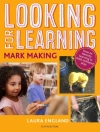The message of the book is straightforward and easy to apply: it derives from the interweaving of long years of field work with a solid theoretical background. The practice advocated presents children with the opportunity to confront contents and situations which are only too often considered inaccessible for them. The abundant examples presented show that when provided with an adequate toolkit composed of graphic texts, children are inherently motivated by the challenges surrounding them and can make the most out of them as valuable learning opportunities. Drawings, icons, photographs, maps and calendars are incorporated into the tool-kit while they are being used in circumstances in which they are required: children appropriate them while exposed to their use and experience their affordances. Children realize how the graphic texts empower their performance.
The fact that this toolkit is multimodal (involves several sensory modalities) implies that those for whom language is not the most readily available means of communication and processing are not discriminated against: on the one hand, it facilitates conceptualization and its expression by alternative means, and on the other it supports both the comprehension and production of verbal language.
Tabla de materias
Chapter 1. Introduction; The Structure of the Book; Graphic Texts as Permanent External Symbol Systems; The Development of Perception and Understanding of Graphic Texts; Use of Non-verbal Graphic Texts at Preschool; Pedagogical Approach; Chapter 2. Drawings and Illustrations; The Development of the Ability to Interpret Drawings as Symbols; The Development of the Ability to Produce Representational Pictures; The Cognitive and Communicative Functions of Drawings; Illustrations; Drawings and Illustrations as a Bridge to Writing; Narrative Illustrations; Scientific Illustrations; Children’s Ability to Distinguish between Narrative Illustrations and Scientific Illustrations; Activities with Illustrations; Chapter 3. Photographs; Photography; Photographic Genres; Curatorship; The Development of the Comprehension of the Object – Photography – Photograph Relationship; The Contribution of Photography to the Interaction in Educational Settings; Activities with Photographs; Chapter 4. Icons: Concise and Easy to Combine Symbols; Introduction; Represented Contents; Perception and Understanding of Icons; Effective Icon Design; Preschool Children’s Understanding and Designing of Icons; Using Icons in Preschool; Activities with Icons; Chapter 5. Maps; Cognitive Spaces; Representation of Spatial Relationships from a Developmental Perspective; Maps as Tools for Spatial Representation; Factors That Influence the Ability to Identify Objects and Locations in Maps; Spatial Representation in Maps and People’s Ability to Navigate; Map Drawing; Maps as Empowering Tools for Preschool Children’s Interaction with Their Surroundings; Activities with Maps; Chapter 6. Calendars as Tools for the Development of Time Notions; Concepts of Time; The Development of Time Concepts among Children; The Contribution of Calendars to the Extension of Cognition and Conceptualization of Time; Activities with Calendars; Chapter 7. Epilogue: Integrated Texts; Appendix: Activity with a Weekly Calendar; Bibliography;












